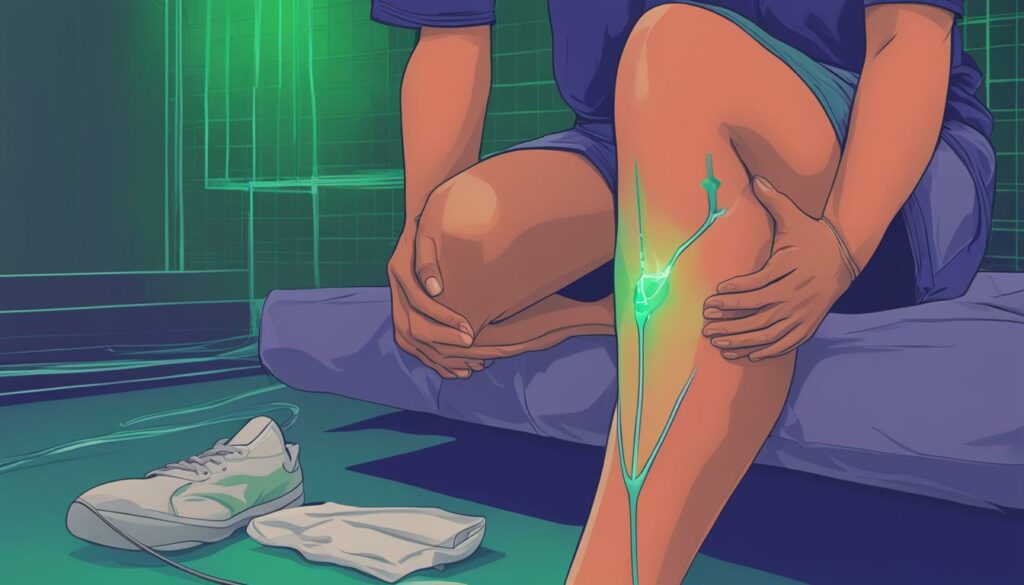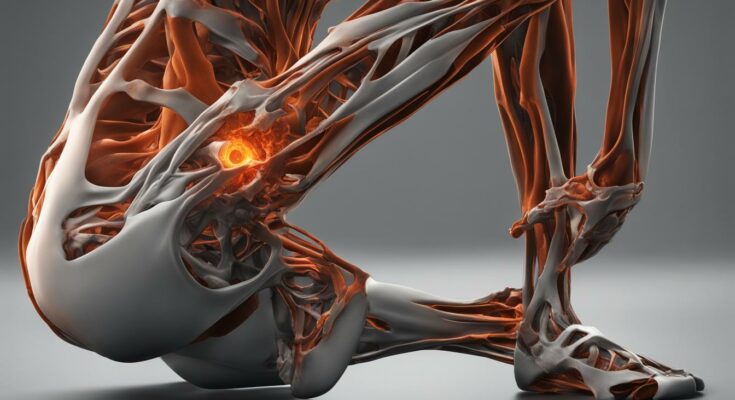Patients with severe iron deficiency, malabsorption, or intolerance to oral iron are often treated with intravenous iron replacement. However, one common side effect of iron therapy is joint pain after the infusion. This joint pain can occur in various joints such as the knee and wrist and is typically temporary. The cause of this joint pain is believed to be related to the generation of free iron following the iron infusion, which can promote oxidative joint and muscular injury. It is important to pay attention to the occurrence of joint pain after iron infusion and provide appropriate clinical observation and management.
Key Takeaways:
- Iron infusion can cause joint pain after the treatment.
- The pain is usually temporary and affects various joints.
- Free iron generated during the infusion may contribute to oxidative joint and muscular injury.
- Close clinical observation and appropriate management are necessary for patients experiencing joint pain post iron infusion.
- Alternative iron formulations or routes of administration may be considered to minimize side effects.
Case Study of Iron Infusion-Induced Joint Pain
In a case study of a 42-year-old woman with non-erosive oligoarticular arthritis and iron deficiency anemia, joint pain was observed after iron infusion. The patient initially experienced transient pain in her knee and wrist joints after the first infusion of ferric gluconate. The symptoms resolved when the dose was halved for the next four infusions. However, after a subsequent infusion, the patient developed severe leg pain, muscular and joint stiffness, and functional impairment in her hands, foot, and ankle. Laboratory tests showed increased markers of inflammation, which normalized several days after the infusion. This case suggests that intravenous iron infusions can lead to joint pain and stiffness, possibly due to oxidative joint and muscular injury.
| Iron Infusion Side Effects | Joint Pain | Complications |
|---|---|---|
| Transient pain after initial infusion | Pain in knee and wrist joints | Resolution with reduced dose |
| Severe leg pain and stiffness | Muscular and joint stiffness | Functional impairment in hands, foot, and ankle |
| Increased inflammation markers | Normalization after several days | Possible oxidative injury |
This case study highlights the potential complications associated with iron infusion, particularly joint pain and stiffness. It reinforces the importance of closely monitoring patients during and after the infusion to detect and manage any adverse effects. Healthcare providers should be aware of the possible reasons for joint pain after iron infusion, including oxidative joint and muscular injury. By understanding such complications, healthcare professionals can optimize patient care and provide appropriate management strategies.
Understanding Rhabdomyolysis as a Possible Cause
Rhabdomyolysis is a condition characterized by the breakdown of muscle tissue that can be caused by various factors, including certain medications and toxins. While rhabdomyolysis is not commonly reported as an adverse event of intravenous iron infusion, it has been suggested as a possible cause of joint pain following iron infusion. The increased free iron generated by iron administration can promote oxidative joint and muscular injury, leading to symptoms such as joint pain and stiffness.
It is important to consider rhabdomyolysis as a possible underlying cause of joint pain after iron infusion and provide appropriate medical observation and management.

| Possible Causes of Joint Pain Post Iron Infusion |
|---|
| Rhabdomyolysis |
| Oxidative joint and muscular injury |
| Free iron generation |
Rhabdomyolysis involves the breakdown of muscle tissue, which can lead to the release of cellular components, including myoglobin, into the bloodstream. The myoglobin can then cause kidney damage and potentially result in joint pain and stiffness. While the exact mechanism of how rhabdomyolysis may contribute to joint pain following iron infusion is not fully understood, the association between the two has been observed in some cases.
It is important for healthcare providers to be aware of the potential link between iron infusion and joint pain, particularly if other causes have been ruled out. By considering rhabdomyolysis as a possible underlying cause, appropriate medical observation and management can be provided to minimize the impact of joint pain on patients’ quality of life.
Further research is needed to better understand the relationship between iron infusion, rhabdomyolysis, and joint pain and to develop strategies to prevent or manage this side effect. By gaining a deeper understanding of the potential causes and mechanisms behind joint pain post iron infusion, healthcare providers can improve patient care and optimize treatment outcomes.
Other Adverse Effects of Iron Infusion
In addition to joint pain, iron infusion with ferric gluconate can cause various other adverse effects. These include bloating or swelling of the face, blurred vision, chest pain, confusion, difficulty breathing, headache, rapid weight gain, sweating, and tingling of the hands or feet.
“Iron infusion with ferric gluconate can cause various other adverse effects.”
While these side effects may occur, they are not common and may not require medical attention. It is important for patients to be aware of these potential side effects and consult with their healthcare providers if they have any concerns.
“Patients should be aware of the potential side effects and consult their healthcare providers if necessary.”

Recognizing Symptoms: When to Seek Medical Attention
While most adverse effects of iron infusion are temporary and mild, there are certain symptoms that should prompt immediate medical attention. If you experience severe chest pain, difficulty breathing, or any other severe symptoms after an iron infusion, it is essential to seek medical help without delay.
Monitoring and Reporting Adverse Events
Healthcare providers should closely monitor patients during and after iron infusion for any adverse events, including those mentioned above. It is crucial to report any observed adverse events to the appropriate regulatory authorities to contribute to patient safety.
Management and Prevention
To manage and prevent joint pain after iron infusion, healthcare providers can consider several strategies. These include:
- Adjusting the iron infusion dosage: Healthcare providers can fine-tune the iron infusion dosage to find the optimal level that minimizes adverse effects, such as joint pain. By carefully monitoring the patient’s response, healthcare providers can tailor the dosage to achieve the desired therapeutic effect while minimizing discomfort.
- Close monitoring during and after infusion: It is crucial to closely monitor patients during and after iron infusion to detect any signs of joint pain or other complications. Regular check-ups and follow-up appointments provide an opportunity to assess the patient’s condition and address any concerns promptly.
- Considering alternative iron formulations or routes: In some cases, healthcare providers may explore alternative iron formulations or routes of administration to minimize side effects. Different iron preparations may have varying effects on joint pain, and healthcare providers can weigh the benefits and risks of different options to optimize patient care.
By combining these management and prevention strategies, healthcare providers can strive to minimize the occurrence and severity of joint pain following iron infusion, improving the overall treatment experience for patients.
Expert Insights:
“Close monitoring of patients during and after iron infusion helps us identify any early signs of joint pain or complications. By adjusting the iron infusion dosage and exploring alternative formulations or routes, we can effectively manage and prevent joint pain, providing patients with a more comfortable treatment experience.” – Dr. Sarah Thompson, Rheumatologist
Conclusion
Joint pain following iron infusion is a common side effect that can occur in some patients. This joint pain is believed to be caused by the generation of free iron, which can lead to oxidative damage in the joints and muscles. While rhabdomyolysis is not commonly reported, it should be considered as a potential underlying cause of joint pain after iron infusion.
Healthcare providers play a crucial role in monitoring patients for joint pain and other adverse effects during and after iron infusion. By closely observing patients and providing appropriate management strategies, healthcare providers can ensure early detection and effective management of joint pain following iron infusion.
Understanding the causes and potential complications of joint pain post iron infusion is essential for healthcare providers to optimize patient care. By being aware of the underlying mechanisms and implementing appropriate strategies for management and prevention, healthcare providers can minimize the impact of joint pain and provide better outcomes for patients.
FAQ
What causes joint pain after iron infusion?
Joint pain after iron infusion is believed to be caused by the generation of free iron following the infusion, which can promote oxidative joint and muscular injury.
Are joint pain and stiffness common side effects of iron infusion?
Yes, joint pain and stiffness can occur as common side effects of iron infusion due to oxidative joint and muscular injury.
Can rhabdomyolysis be a cause of joint pain after iron infusion?
While not commonly reported, rhabdomyolysis, the breakdown of muscle tissue, has been suggested as a possible cause of joint pain following iron infusion.
What are the other adverse effects of iron infusion?
Other adverse effects of iron infusion can include bloating or swelling of the face, blurred vision, chest pain, confusion, difficulty breathing, headache, rapid weight gain, sweating, and tingling of the hands or feet.
How can joint pain after iron infusion be managed and prevented?
To manage and prevent joint pain after iron infusion, healthcare providers can adjust the iron infusion dosage, closely monitor patients throughout and after the infusion, consider alternative iron formulations or routes of administration, and discuss potential risks and benefits with patients.




